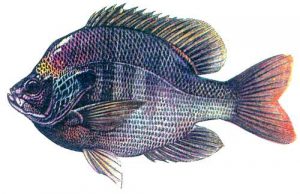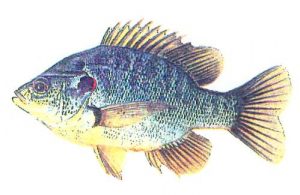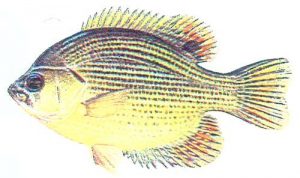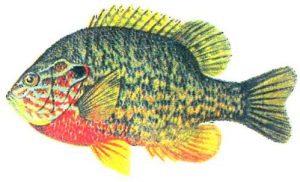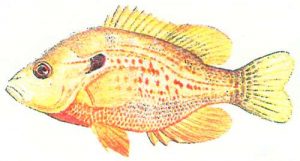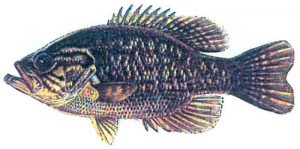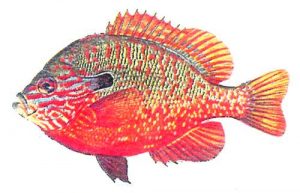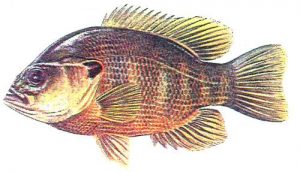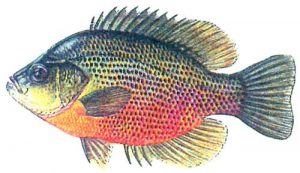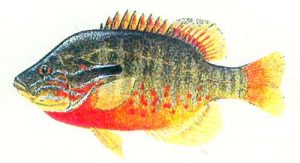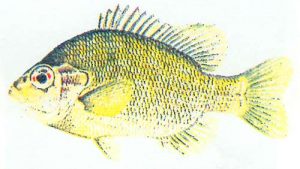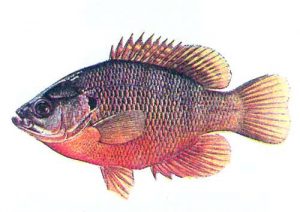~ Click on any image for enlargement ~
Sunfish – A Comprehensive Guide
Bluegill
LOCAL NAMES AND VARIATIONS USED: Copperbelly, Bream, Sunfish, Sunperch, Blue Sunfish, Brim
The most popular of Panfish in the country is the Bluegill. Bluegills all have a small mouth and a dark spot near posterior dorsal fin base. The mouth does not extend past the eye. The sides of the fish are normally marked by 6-8 vertical, irregular bars. The shape of the male breeding male or bull bream has a more compressed dark body with small short heads. The Bluegill’s color varies more then any other sunfish. Colors range from yellow to dark blue, sometimes maybe colorless, pale blue to dark olive with brown, copper or hints of turquoise.
Bluegill loves quiet water and scattered aquatic vegetation where they can feed and hide. They prefer clear water. The larger fish stays in deeper water in the daylight hours, but moves into shallow regions in the morning and eveiling to feed. The smaller fish stay close to the shore in the daytime.
Their food consist of insects and some vegetation. The major part of their diet consist of mayflies, damselflies, and crustaceans. In the summer when food sources becomes scarce they will feed on aquatic vegetation.
The Bluegill in Toledo Bend spawn normally around the middle of April, depending on water conditions and temperature. However spawning may continue into late summer. Their nests are saucierlike depressions made in sand and gravel and are guarded by the male. A female is capable of laying 38,000 eggs. They will hatch in around 2-5 days depending on weather conditions. The young are protected by the males for a few days after hatching and then they are own their own. The young grow over an inch in its first year and reach 4 to 6 inches in 3 years if competition is not thick. A six to eight year old bream can attain a length of 9 inches. In the southern area of their range they grow faster and may attain a 4 inch span in the first summer.
Originally restricted to western and central North America where it ranged from coastal Virginia to Florida, west to Texas and northern Mexico, and north from western Minnesota to western New York. It has also been widely and successfully introduced outside this area and into Europe and South Africa.
Redear Sunfish
LOCAL NAMES AND VARIATIONS USED: Chinquapin, Shellcracker, Mason Bream, Tupelo Bream, Mongrel Bream, Yellow Bream, Stumpknocker, GI (Government Improved) Bream
A very popular Panfish of the South. The Redear posses a black opercular spot broadly margined with a scarlet in the adult male (white or orange in females and the immature). The gill flap of the Redear is semiflexible, bending to right angles. The mouth of the Redear are slightly larger than a Bluegill’s, but there are hard, crusher-type in the throat.
The general dorsal coloration is olive with darker specks. The lateral surfaces are somewhat lighter with brassy overtones. Dark brown spots are sometbl1es pronounced on the lower lateral surfaces. Breeding males do not undergo the morphological change such as Bluegill do (humpbacked condition).
Its popularity as a sport fish is enhanced by its rather large size. It can exceed 10 inches in length and weight over 4 pounds.
The Redear Sunfish is typically southeastern in distribution, but has been introduced into several states. Its normal range occurs from the Mississippi River basin in Indiana and Missouri south to the Gulf Coast.
In Louisiana it can be found more frequently in nonflowing areas where there is abundant vegetation, especially brush, stumps or logs.
Redears depend largely on mollusks for food and does not compete severely with insect-eating fish. The Redear has highly developed grinding teeth or shell crackers located in its throat, which are capable or crushing snails, it favorite bill of fare.
Redears are less attracted to artificial lures than most Sunfishes. Worms and crickets are the usual baits. However, Redears can be caught readily on wet flies, spinners and jigs that are fished deep and twitched slowly along.
Flier
LOCAL NAMES AND VARIATIONS USED: None
The Flier is a Southern species of sunfish that belong to the Centrarchus. The Flier is a short bodied sunfish that appears almost round in profile. Both young and adult specimens posses obvious features of pattern and structure which make identification easy. Its most distinguishing characteristic is the anal fin, which is almost as long as the dorsal fin.
The Flier is greenish in color and becomes more yellowish ventrally with dark spots on each scale below the lateral line forming longitudinal lines. There is a black spot below each eye, and a black spot on the posterior portion of the dorsal fin. The head is small, the snout pointed and short, and the mouth is small and oblique. Two patches of teeth occur on the tongue.
Spawning takes place in late spring or early summer. One female Flier female, 5 inches long can contain 5,600 eggs.
It ranges from Virginia to East Texas and north to Southern Illinois and Indiana. In Louisiana, the Flier occurs statewide, but does not appear to be abundant as most sunfishes.
Fliers feed on insect larvae, particularly mosquito larvae, and other small organisms.
The prefer sluggish, lowland habitat with clear, heavily vegetative waters, often in areas of highly acid waters where other sunfish species are restricted. The maximum weight is 1 pound and can reach a length of 8 inches. In Louisiana, they sometimes exceed 8″ in total length.
Pumkinseed
LOCAL NAMES AND VARIATIONS USED: Common Sunfish
This Sunfish is easity caught, colorful and a good scrappy fighter. It is easity identified by the rigid black gill cover with bright red or orange spot on the tip. The body is light olive with a sprinkling of various colored spots on the sides. Emerald blue lines radiate backward from the snout and eye area. The mouth is small and does not extend beyond the front of the eye. The pectoral fins are long and pointed. The young of the Pumkinseed have a yellow belly, which helps to distinguish it from young Bluegill.
This species is a transplant from its northern range. Original distributions includes the Dakotas east to the Marine Provinces of Canada, south along the Attantic Coast to northern Georgia, and in the Mississippi River system from western Pennsylvania to Iowa.
Pumkinseed likes standing water with soft bottom covered with plant material. It prefers weed patches, docks and logs for cover. They normally don’t like the open water like Bluegill.
ThePumkinseed feeds on small mollusks, insects, and fish, with fish being its main food, including its own young.
The spawning season of pumkinseed are similar to Bluegill and occur at the same time. Its saucer shaped nests are excavated in colonies sometimes between late May and early July. The female laysseveral thousand eggs in the nest which are guarded by a male. The eggs hatch in 5-10 days. Maturity is usually reached at 2 years. It can reach a size of greater than 6 inches.
Orange Spotted Sunfish
LOCAL NAMES AND VARIATIONS USED: Redspotted Sunfish, Dwarf Sunfish, Pygmy Sunfish
This Sunfish outstanding feature is the 20-30 bright red orange spots scattered irregularly on the sides of the male. The female has the sarne color pattern, but brown spots. The black gill flap is margined with white, and the sides of the head are often streaked with brown or red. The pectoral fin is short and broadly rounded and the gill rakes are moderately long. The adult coloration is olive-green dorsaJly with blue or light green overtones. The sides are lighter and the belly white. The adult seldom exceeds 4 1/2 inches.
The Orange Spotted Sunfish usually spawns in colonies in water that is less then 3 feet deep. On occasions the water is just deep enough to cover their bodies. It spawns from April to September in Louisiana. Parents guard the nest. Insects constitute its major food source. However, they will eat crustaceans and occasionally small fish.
The Orange Spotted Sunfish ranges throughout a wide area of central United States from West Texas north along the eastern slope, of the Rocky Mountains to North Dakota throughout the Great Plains then east to Lake Erie and south throughout the Mississippi Valley. In Louisiana, it can be found in borrow pits, drainage ditches, small bayous, quiet str,earns and in vegetative lakes and ponds.
It does not reach sufficient size to be an attractive food fish
Warmouth Sunfish
LOCAL NAMES AND VARIATIONS USED: Goggle-eye, Stumpknocker, Goggle-eye Perch
Most fishermen normally don’t go looking for Warmouth, but catch them while fishing for other panfish. The thickbodied Warmouth resembles the Rock Bass, but can be distinguished from the latter by the 3 spines on the anal fin, teeth on the tongue, and the small spots on the dorsal and anal fins. The color varies from olive to gray, with mottled markings on sides and back. The mouth is large, extending beyond the eye, and the eyes are reddish. Maximum length is about 11 inches and may weigh a little over a pound.
The species occurs throughout all but the extreme Northeastern area of the Eastern half of the United States. The Warmouth prefers dense weed beds and soft bottoms, but if these conditions do not occur it then can be found around stumps, hence the name stumpknockers. It has more tolerance for muddy water than most species.
The food of this Sunfish is crawfish, aquatic insect larvae, and fishes. Most of the feeding is done early in the morning. By afternoon the feeding ceases.
The Warmouth reaches sexual maturity at about 3 1/2 inches. It spawns from early summer to mid-August. The male builds the nest in water from 6 inches to 5 feet deep. Female can layover 126,000 eggs.
Longear Sunfish
LOCAL NAMES AND VARiATIONS USED: Pumkinseed, Creek Perch, Sun Perch
The longear is a highly colored sunfish which can be distinguished from other Sunfishes by its exceptionally long, flexible gill flap, which is narrowly bordered with scarlet. Its sides are flecked with blue or yellow, and the cheeks have irregular lines of blue or green. Their color is olive above and the sides are spotted with orange, emerald or turquoise. The breast and belly are yellow or red in color.
The head profile is sharp, the pectoral fin is short and rounded, and the mouth is moderately large, ending under the eye. They can reach a’iength of 9 inches and 10 ounces in weight.
The Sunfish builds a nest like most of the other Sunfishes and spawn from June until August in their Northern range, and a little earlier in the South. It reaches sexual maturity in the-third summer. Adult males often exhibit intense coloration, a deep body and a humped back.
Their food is primarily aquatic insects, crustaceans, and small fishes.
The Longear Sunfish inhabits a wide area of the east central United States. It is found from Minnesota, throughout the Great Lakes to Ohio and western Pennsylvania in the n,orth and southward through the Mississippi Valley to the Gulf. On the east coast it ranges northward to South Carolina.
In Louisiana it is common in almost all freshwater and appears in greatest numbers in backwaters where ample aquatic vegetation occurs.
Green Sunfish
LOCAL NAMES AND VARIATIONS USED: Rice-field Slick, Slick, Pond Perch, Shade Perch, Black Perch, Green Perch, Rubbertail, Blue-spotted Sunfish, Sand Bass, Sunfish
Green Sunfish are very common in lakes and streams throughout Louisiana. They are commonly found in the backwaters of creeks, rivers, bayous, and lakes and is well suited to muddy water with variable oxygen content, temperature and flow. They seem to prefer extra weedy, sluggish, mud-bottomed hideouts in silty and sometimes stagnant water.
The Green Sunfish has heavy lips and a large mouth that extends beyond the front of the eye. The pectoral fin is short and rounded, not reaching past the front of the eye when bent forward. The ear flap is never greatly prolonged.
One of its most distinctive features is the fin coloration. Most individuals possess a dark spot at the posterior base of the soft dorsal and anal fins. The caudal and anal fins are also margined with white, yellow or orange, during .tbe breeding season the males are very bright. Body color is bluish green with emerald and yellow reflections. Spots may be present on the lateral surfaces and tend to form rows in some specimens.
The breeding habitats of the green sunfish are similar to those of the Bluegill. They spawn in colonies in shallow water. The saucer-shaped nests are built and guarded by the males. Spawning takes place from May through August. The number of eggs varies from 2,000-10,000 per female. They reach maturity and spawn at 2 years of age at a length of about 3 inches. .
The Green Sunfish feeds on insects, small crustaceans, and small fishes.
Spotted Sunfish
LOCAL NAMES AND VARIATIONS USED: Stumpknocker, Spotted Bream
This is one of the least known of the small sunfishes. It has an olivaceous spotted body. The spots being black, red, redpurple, or brown in color. It has a plain spot on the gill flap and no blotch on the dorsal fin. Each scale is pigmented at the base, and the pectoral fins are rounded. The mouth is small and the fill rakers are rather short and thick. Its coloration is distinctive. The general body color is dark olive, but most adults posses squarish red-purple spots arranged in rows on the side of the body. The ventral surface is lighter with brassy overtones. It seldom exceeds 6 inches in length.
It ranges from South Carolina to Florida and from southern Illinois to Mississippi and west toTexas. In Louisiana it is found in the quieter waters of lakes, bayous, and streams. It is not normally found in great numbers, so anglers do not normally pursue it as a sport fish.
Redbreast Sunfish
LOCAL NAMES AND VARIATIONS: Yeliowbelly Sunfish, Longear Sunfish, Sun Perch, or Redbreast Bream
The Redbreast is one of the brightest colored and most game of the medium sized Sunfish. It is usually yellow on the sides and crimson on the ventral surface, particularly in the breeding season. The distinguishing character of this Sunfish is the long, black gill flap, which is narrower than the eye and has no yellow or red trim. The mouth is small and does not extend beyond the eye. The pectoral fins are short and round. The maximum size is about 11-12 inches and 1 1/2 pounds.
Its native range was from New Brunswick east of the Alleghenies to Florida. It has been transplanted into areas of west Louisiana, east Texas, southeast Oklahoma, Arkansas and Alabama. It is found in lakes and ponds, but it tends to be more of a river species than most other Lepomis.
Its food consists of crustaceans, insects, and small fishes.
Its spawning habits is similar to those of the Bluegill. When the temperature reaches 68 F., a shallow nest about 12 inches in diameter is fanned out in the gravel by the male. He then guards the nest and protects the young for a short period after they hatch.
Dollar Sunfish
LOCAL NAMES AND VARIATIONS USED: None
The Dollar Sunnsh was once considered to be a dwarf relative of the Longear Sunfish and a southeastern subspecies of that form. In general appearance, the Dollar looks like the Longear Sunfish, but has a shorter, deeper body and has a shorter fill flap with a broader, lighter margin and larger scales.
The Dollar is olive, with orange spots, but pigmentation is variable, and many continue streaks of emerald on the sides and cheeks. The belly is yellow or orange. This is a small sunfish rarely reaching a size of 6 inches.
Its range is more restricted than most other members of the Lepomis. Its habitat is the Southern coastal drainage areas from North Carolina to Texas and North through Central Mississippi basin to Kentucky and Arkansas. Usually common to abundant in swamps and sluggish streams.
Bantam Sunfish
LOCAL NAMES AND VARIATIONS USED: None Known
A small Sunfish with rounded, deep body. The color of this Sunfish is olive-brown with dark copper flecks, which may form shadowy longitudinal bars in some. The ventral color is yellow-brown. A dark spot is prominent at the base of the dorsal fin. This spot will be less intense in younger, smaller fish.
Its food consists of insect larvae and normally its length does not exceed three inches. This is the smallest species of Lepomis. Therefore it is not fished by anglers.
This Sunfish is found in the Mississippi drainage basin from southern Illinois to Louisiana. It can be found most often by aquatic vegetation growing near the shore of lakes, bayous and backwaters of rivers and streams.
This information and pictures provided by John Rogers, USDA Natural Resources Conservation Service, Many, La. field office.





